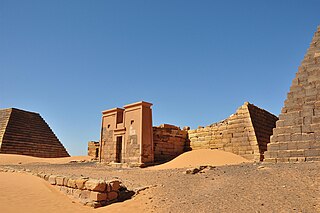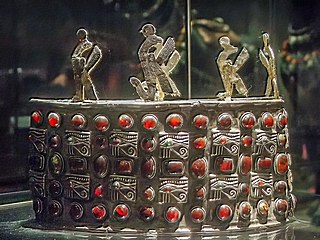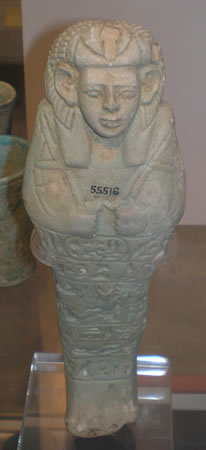Upper Egypt is the southern portion of Egypt and is composed of the Nile River valley south of the delta and the 30th parallel N. It thus consists of the entire Nile River valley from Cairo south to Lake Nasser.
Nubians are a Nilo-Saharan ethnic group indigenous to the region which is now Northern Sudan and Southern Egypt. They originate from the early inhabitants of the central Nile valley, believed to be one of the earliest cradles of civilization. In the southern valley of Egypt, Nubians differ culturally and ethnically from Egyptians, although they intermarried with members of other ethnic groups, especially Arabs. They speak Nubian languages as a mother tongue, part of the Northern Eastern Sudanic languages, and Arabic as a second language.

Kerma was the capital city of the Kerma culture, which was located in present-day Sudan at least 5,500 years ago. Kerma is one of the largest archaeological sites in ancient Nubia. It has produced decades of extensive excavations and research, including thousands of graves and tombs and the residential quarters of the main city surrounding the Western/Lower Deffufa.

Lower Nubia is the northernmost part of Nubia, roughly contiguous with the modern Lake Nasser, which submerged the historical region in the 1960s with the construction of the Aswan High Dam. Many ancient Lower Nubian monuments, and all its modern population, were relocated as part of the International Campaign to Save the Monuments of Nubia; Qasr Ibrim is the only major archaeological site which was neither relocated nor submerged. The intensive archaeological work conducted prior to the flooding means that the history of the area is much better known than that of Upper Nubia. According to David Wengrow, the A-Group Nubian polity of the late 4th millenninum BCE is poorly understood since most of the archaeological remains are submerged underneath Lake Nasser.

The Kerma culture or Kerma kingdom was an early civilization centered in Kerma, Sudan. It flourished from around 2500 BC to 1500 BC in ancient Nubia. The Kerma culture was based in the southern part of Nubia, or "Upper Nubia", and later extended its reach northward into Lower Nubia and the border of Egypt. The polity seems to have been one of a number of Nile Valley states during the Middle Kingdom of Egypt. In the Kingdom of Kerma's latest phase, lasting from about 1700 to 1500 BC, it absorbed the Sudanese kingdom of Sai and became a sizable, populous empire rivaling Egypt. Around 1500 BC, it was absorbed into the New Kingdom of Egypt, but rebellions continued for centuries. By the eleventh century BC, the more-Egyptianized Kingdom of Kush emerged, possibly from Kerma, and regained the region's independence from Egypt.

Apedemak or Apademak was the Chief deity in the ancient Kushite pantheon. Often depicted as a figure with a male human torso and a lion head, Apedemak was a war god worshiped by the Meroitic peoples inhabiting Kush. He has no Egyptian counterpart. As a war god, Apedemak came to symbolize martial power, military conquest, and empire for the Meroitic peoples. Apedemak is also closely associated with Amun, the state-sponsored Egyptian deity during the preceding Napatan period, and is assumed to hold an equal level of importance.
The A-Group culture was an ancient culture that flourished between the First and Second Cataracts of the Nile in Lower Nubia. It lasted from c. 3800 BC to c. 3100 BC.

The North African elephant is an extinct subspecies of the African bush elephant, or possibly a separate elephant species, that existed in North Africa, north of the Sahara, until it died out in Roman times. These were the famous war elephants used by Carthage in the Punic Wars, their conflict with the Roman Republic. Although the subspecies has been formally described, it has not been widely recognized by taxonomists. Other names for this animal include the North African forest elephant, Carthaginian elephant, and Atlas elephant. Originally, its natural range probably extended across North Africa and down to the present Sudanese and Eritrean coasts.
Sekhmakh was the wife of the Nubian king Nastasen, who ruled in the Fourth century BC.

Nubian architecture is diverse and ancient. Permanent villages have been found in Nubia, which date from 6000 BC. These villages were roughly contemporary with the walled town of Jericho in Palestine.

Nubia is a region along the Nile river encompassing the area between the first cataract of the Nile and the confluence of the Blue and White Niles, or more strictly, Al Dabbah. It was the seat of one of the earliest civilizations of ancient Africa, the Kerma culture, which lasted from around 2500 BC until its conquest by the New Kingdom of Egypt under Pharaoh Thutmose I around 1500 BC, whose heirs ruled most of Nubia for the next 400 years. Nubia was home to several empires, most prominently the Kingdom of Kush, which conquered Egypt in the eighth century BC during the reign of Piye and ruled the country as its 25th Dynasty.

The Kingdom of Kush, also known as the Kushite Empire, or simply Kush, was an ancient kingdom in Nubia, centered along the Nile Valley in what is now northern Sudan and southern Egypt.

Egypt has a long and involved demographic history. This is partly due to the territory's geographical location at the crossroads of several major cultural areas: North Africa, the Middle East, the Mediterranean and Sub-Saharan Africa. In addition, Egypt has experienced several invasions and being part of many regional empires during its long history, including by the Canaanites, the Ancient Libyans, the Assyrians, the Kushites, the Persians, the Greeks, the Romans, and the Arabs.

Kemsit was an ancient Egyptian queen consort, the wife of pharaoh Mentuhotep II of the 11th Dynasty. Her tomb (TT308) and small decorated chapel were found in her husband's Deir el-Bahari temple complex, behind the main building, along with the tombs of five other ladies, Ashayet, Henhenet, Kawit, Sadeh and Mayet. Most of them were priestesses of Hathor, so it is possible that they were buried there as part of the goddess's cult, but it is also possible that they were the daughters of nobles the king wanted to keep an eye upon.

The X-Group Culture was an ancient Nubian civilization that existed in Lower Nubia. Cemetery excavations revealed that the civilization stretched from the Dodekaschoinos in the north to Delgo in the south.

Nasalsa was a Nubian queen of the Kingdom of Kush. She is known from a shabti, some inscriptions on tablets and cups, text on the stela of Khaliut, a dedication inscription and a text from Kawa. Dodson mentions that Nasalsa is named on the Enthronement Stela of Atlanersa and on the Election and Adoption Stelae of Aspelta. These stelae were from Gebel Barkal.

Nawidemak was a queen regnant of Kush who probably ruled in the first half of the 1st century AD. She is known from the wall relief of her burial chamber, as well as a gold plaque.

Sebiumeker was a major supreme god of procreation and fertility in Nubian mythology who was primarily worshipped in Meroe, Kush, in present-day Sudan. He is sometimes thought of as a guardian of gateways as his statues are sometimes found near doorways. He has many similarities with Atum, but has Nubian characteristics, and is also considered the god of agriculture.

Nubia is a region along the Nile river encompassing the area between the first cataract of the Nile as well as the confluence of the blue and white Niles or, more strictly, Al Dabbah. Nubia was the seat of several civilizations of ancient Africa, including the Kerma culture, the kingdom of Kush, Nobatia, Makuria and Alodia.

Kushite religion is the traditional belief system and pantheon of deities associated with the Ancient Kushites, who founded the Kingdom of Kush in the land of Nubia in present-day Sudan.
















